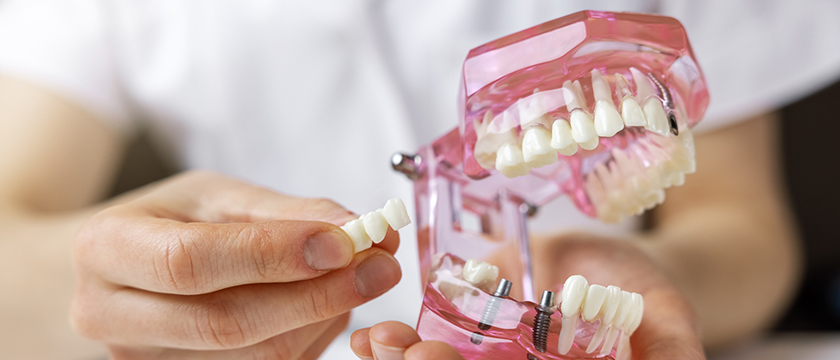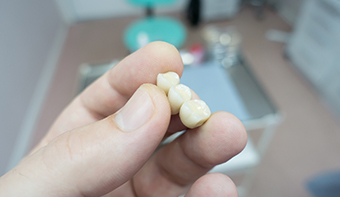 05 Aug 2022
05 Aug 2022
Tooth loss is an extremely common dental problem for Canadians, especially older individuals. Unfortunately, this loss can lead to many other problems, including difficulty speaking and eating as well as low self-esteem.
A dental bridge is a versatile, visually impressive, and cost-effective solution for replacing one or more missing teeth. Our guide to dental bridges will tell you everything you need to know, including whether you might benefit from getting one.
What Is a Dental Bridge?
Dental bridges are dental prostheses that are used to disguise missing teeth in a person’s mouth.
Dental bridges look like small rows of false teeth. They may be made from porcelain, ceramic fused to metal, or other materials. The teeth on each end of the row are hollow and resemble dental crowns. These false teeth are called retainers and are fitted over your natural teeth to keep the bridge in place. The teeth they are fitted to are called abutment teeth.
The teeth in between the retainers are solid and do not connect to the teeth or gums below them. These teeth are called pontics. Depending on your needs, there may be just one false tooth on your bridge’s pontic or many.
What Do Dental Bridges Look Like?
A permanent dental bridge is almost indistinguishable from the teeth around it. It should fit into your natural alignment and look just like the teeth it has covered and replaced, matching their colour, shape, and other attributes.
Most people will never know that a bridge is not a real row of teeth unless you tell them. You can smile with confidence and trust your bridge to help you make a winning first impression.
When Is a Dental Bridge Necessary?
Dental bridges are never necessary, but they can significantly improve a person’s quality of life. Using them to replace lost teeth allows you to speak and chew the way you did before those teeth were missing. They may also boost your self-confidence and help you feel at ease when smiling and laughing.
Bridges are particularly recommended for people who are not good candidates for implants due to gum disease, bone loss, and other problems. A bridge helps these people regain some lost aesthetics and function without compromising their dental or overall health.
Your dentist may also recommend a bridge if you have teeth on either side of your missing tooth that would benefit from being crowned. By choosing a bridge, you can protect those weaker teeth while also replacing the missing one.
4 Dental Bridge Types
When looking to get a bridge, there are four main types.
- Traditional Bridges. Traditional bridges are the most common type of bridges. They use two retainers and two abutment teeth to keep the pontic stable and provide superior aesthetics.
- Maryland Bridges. Maryland bridges are a simpler version of conventional bridges. Instead of attaching to your teeth using cemented retainers, they are anchored by wings attached to the pontic. Maryland bridges are simple and inexpensive, but they are not strong. They are usually only used for front teeth that will not have to bear much biting stress.
- Cantilever Bridges. Cantilever bridges closely resemble traditional bridges, but they have only one anchor tooth instead of two. This design allows you to preserve more tooth structure overall, but it is less stable than a traditional bridge. This is why cantilever bridges are rarely used today.
- Implant-Supported Bridges. Implant-supported bridges are a new type of bridge that significantly deviates from the traditional design. Instead of anchoring the pontic to abutment teeth, this type of bridge is anchored by two implants on either side of the bridge. Implant-supported bridges offer the best support, but they are also the most expensive and invasive bridge options.
Procedure for Dental Bridges
Getting a dental bridge often involves two steps.
- Tooth Preparation and Temporary Bridge Placement. Your dentist will prepare the abutment teeth. They will remove some of the enamel from the outside of these teeth to make room for the prosthesis that will fit over them. When this is done, your dentist will take an impression of your abutment teeth and send this to a lab to have the final prosthetic made. In the meantime, they will place a temporary bridge over your teeth to keep them safe.
- Permanent Bridge Placement. When your bridge is ready, your temporary bridge will be removed and the new one will be cemented in place. Your bite and alignment will be checked before finalizing the process. Once this is done, the bridge cannot be removed without special dental tools. It will remain in place until it needs to be replaced in a few years’ time.
The procedure for implant-supported bridges is a bit different. Instead of getting your teeth prepared for placement, you will need to undergo implant placement surgery. Once your new implants have healed, your bridge can be attached to the screws. This process usually takes a few months from start to finish.
How to Care for a Dental Bridge
You can avoid dental bridge problems by:
- Practicing Good Oral Hygiene. Practice good oral hygiene after receiving your bridge. Brush twice a day, floss once a day, and use a fluoride mouthwash periodically.
- Getting Regular Maintenance. See your dentist for a cleaning and checkup every 6 months and have them examine your dental bridge. They will let you know if your bridge is showing signs of wear or may have tooth decay forming beneath it.
- Eating with Care. Avoid chewing hard or sticky foods on the side of your mouth where your bridge is located. Try not to bite down too hard on that side whenever possible.
Dental Bridge vs. Implant: Which is Best?
Dental bridges and implants are both possible options for replacing a missing tooth. Which is better? This depends on your needs.
Implant Benefits
- Implants are anchored directly into your jaw, making them feel and function almost exactly the same as real teeth.
- Implants simulate the look of natural teeth almost perfectly. They are considered the best dental prosthetics for aesthetic purposes.
Implant Drawbacks
- Implants can be expensive, often costing thousands of dollars apiece.
- Severe bone loss or gum disease may mean you are not a good candidate for this treatment option.
Dental Bridge Benefits
- Dental bridges restore functions like the ability to eat and speak without difficulty.
- Dental bridges erase gaps in smiles and restore your smile aesthetics.
- Bridges are less expensive than implants.
- Most people are good candidates for dental bridges.
Dental Bridge Drawbacks
- Placing a bridge requires large amounts of tooth structure to be removed from your teeth.
- You may develop further tooth decay in the treated tooth.
- The bridge will eventually fail and need to be replaced.
How Much Does a Dental Bridge Cost?
Dental bridge costs vary depending on your dentist, the materials used, and the type of bridge you select. Maryland bridges are typically the most affordable, while implant-supported bridges are the most expensive. Ask your dentist about the different dental bridges and how much each option might cost you. They will be happy to help you fit the cost of this treatment into your budget.
Get High-Quality, Long-Lasting Dental Bridges
 If you are interested in replacing one or more missing teeth, Trillium Smile Dentistry can help. Let our experienced team install a beautiful new dental bridge or implants that will restore your dental functions and your confidence. Contact us today at 905-828-9894 or online to request your first appointment and get the process started.
If you are interested in replacing one or more missing teeth, Trillium Smile Dentistry can help. Let our experienced team install a beautiful new dental bridge or implants that will restore your dental functions and your confidence. Contact us today at 905-828-9894 or online to request your first appointment and get the process started.
